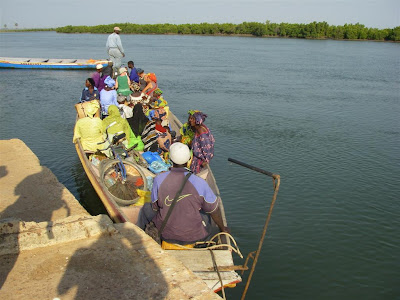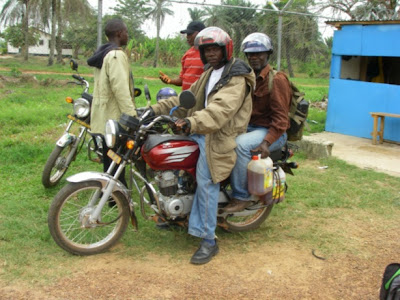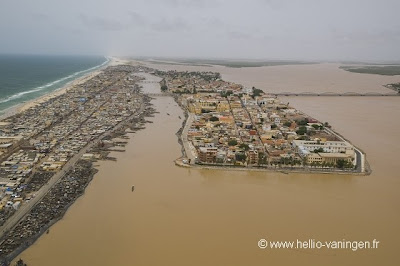2009 has had an interesting start. Throughout January we had visitors from the UK, which was very nice, also giving us an excuse to do some fun things together. Unfortunately, Gina was pretty much locked into her new job with learning the ropes and supervising many activities, preparing for the Peace Corps regional softball tournament, etc.. We and about 100 others enjoyed seeing the Obama investiture on the big screen. During the past two months, Gina has been negotiating her job and its challenges, the future move to another apartment and the (tedious) application process for a 5-year residency permit for Senegal. She has agreed to serve on the monthly advisory board for a local organization called 10,000 Girls - http://www.10000girls.org/.
Bernard had a World Bank micro-finance translation but was able to work around the guests' schedule to enjoy a very nice 10-day trip to lush, green and friendly Casamance and the biggest Senegalese national park, Niokolo-Koba. While no match for the Serengeti or Kruger, we saw many birds, some rare such as a fishing owl, and many delightful ones such as kingfishers and bee-eaters and a few mammals such as warthogs (very common), a few kinds of antelopes (also common), crocodiles and hippos (from a distance only!), one leopard (in a large enclosure supposedly offered by Brigitte Bardot), many baboons and also a few interesting flowers. 
European stork wintering (smartly) in warmer climes.

Giant grey heron

One of the many kingfishers we saw, some irridescent, some just black and white , but all very skillful fish catchers.

A hornbill

Typical Casamance beach village scene

Boat transport is a way of life in Casamance

Ziguinchor, capital of Casamance seen from the ferry.
 The Gambia river with hippos and crocodiles...
The Gambia river with hippos and crocodiles...
 Laid back but messy beach tourists....
Laid back but messy beach tourists....
 Tropical flower power
Tropical flower power
 Basic park accomodation: a bed and a mosquito net, plus cheeky monkeys who come in your hut to steal your bananas!
Basic park accomodation: a bed and a mosquito net, plus cheeky monkeys who come in your hut to steal your bananas!
 Beautiful sunset through a baobab
Beautiful sunset through a baobab
 Pirogues galore, even painted to the national Senegalese colors
Pirogues galore, even painted to the national Senegalese colors
 Typical Casamance waterfront scene
Typical Casamance waterfront scene
Bong county, Liberia, has an equatorial climate, the remnants of a lush forest interspersed with rubber and palm plantations and many returnees from the 15 year civil war that finished in 2004. There is still a general uneasiness, basic services/low capacity and a heavy UN presence (Bangladeshi military and civil engineering). I worked with a pleasant team of 10 short-term recruited people to mainly investigate any report of new caterpillar outbreaks in a wide area, monitor any pesticide spraying performed by the Ministry of Agriculture (low capacity and equipment – more dangerous than the caterpillar!), provide support to the local government agricultural agency managing the response and provide community education to reduce fear and increase mitigation measures' effectiveness.
Overall it was intense but all went well, especially since the rains started unexpectedly early and stopped the outbreak in the most environmental way! However, we did get to see moths and “baby” caterpillars and 2 minor outbreaks of 2 other varieties of caterpillars (good thing that I raised silkworms when in primary school – very useful training – who could have guessed!). The team covered about 15,000km on the back of motorcycles and on foot and I occasionally went along – dusty and hot but pretty nice when when in a forest of rolling hills. The major lasting impact of the outbreak was the contamination of many communities' single source of drinking water and unfortunately that was the part of the national response that was completely bungled (and outside our responsibility).
 Main street, Gbarnga. Dusty and with USAID signs
Main street, Gbarnga. Dusty and with USAID signs
 One of the 10 project scouts ready to find some caterpillars and with spare fuel
One of the 10 project scouts ready to find some caterpillars and with spare fuel
 Pesticide spraying training in villages
Pesticide spraying training in villages Morning planning around a map
Morning planning around a map Typical village with large trees and graves
Typical village with large trees and graves
 Large trees are never far away and occasionally good caterpillar fodder
Large trees are never far away and occasionally good caterpillar fodder Northern Liberian village view
Northern Liberian village view
 A lovely and refreshing waterfall
A lovely and refreshing waterfall
 Equatorial forest as seen from the road
Equatorial forest as seen from the road Rubber plantation
Rubber plantation
The parts I enjoyed least: logistical challenges and lack of resources in Liberia; very hot and humid much of the time, with limited electricity; the usual apathy of government agencies and staff and a high level of corruption (similar to Cambodia); working 6-7 days/week and being away from home for a long time; no pastis. The things I found “interesting”: Liberia has so much US influence, such as hundreds of Christian sects; doughnuts for sale on street corners; US currency and electric plugs (but 220v thankfully); Liblish – a real patois of former US slave “english” - sometimes hard to understand and needing translation into French from some colleagues who had spent years in refugee camps in French speaking Guinea or Côte D'Ivoire; even more expensive than Dakar for much lower “quality” - probably exacerbated by the UN factor. But I would do it again, now that I know what to expect, and I would prepare and organise things differently. The local food was very samey (rice with sweet potato greens, greasy and pimented) but I fortunately stayed at the local Catholic Pastoral Centre which could also cater to Western palates with a bit of insistent coaching.
Bernard's sister, Tiphaine, our across-the-street neighbor with now 5 cats was also starting her career as a regional development consultant and spent a few weeks in very hot inland Bamako in Mali to design pilot micro-finance products for artists. Never a dull moment for all of us and it certainly beats 9-5 office jobs! Now is going to be busy with moving, finding the next job for Bernard but also enjoying what Dakar has to offer: culture (music especially) and the ocean (sailing, snorkeling, scuba, kayaking, waterfront restaurants, beach and birds).
We wish you all a pleasant and happy spring (in the northern hemisphere and the opposite in the upside-down hemisphere).
Bernard, Gina and the ZZs
 Bernard hopelessly trying to keep up with the dress code. This was a farewell luncheon for two members of the advisory committee of a Senegalese NGO dedicated to the education of rural girls. Gina, Tiphaine and I are now also assisting 10000girls. On the left is Viola Vaughn, a very dedicated, dynamic and funny Director "I don't know how it's going to work but it just does" and Rose, also a new committee member.
Bernard hopelessly trying to keep up with the dress code. This was a farewell luncheon for two members of the advisory committee of a Senegalese NGO dedicated to the education of rural girls. Gina, Tiphaine and I are now also assisting 10000girls. On the left is Viola Vaughn, a very dedicated, dynamic and funny Director "I don't know how it's going to work but it just does" and Rose, also a new committee member. Island of St Louis at the mouth of the Senegal river, former capital of French West Africa and now a UNESCO World Heritage Site
Island of St Louis at the mouth of the Senegal river, former capital of French West Africa and now a UNESCO World Heritage Site One of the many kingfishers we saw, some irridescent, some just black and white , but all very skillful fish catchers.
One of the many kingfishers we saw, some irridescent, some just black and white , but all very skillful fish catchers.